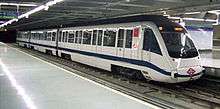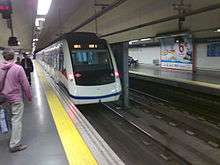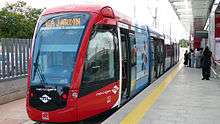Madrid Metro
 | |||
.jpg) | |||
| Overview | |||
|---|---|---|---|
| Native name | Metro de Madrid | ||
| Locale | Madrid, Spain | ||
| Transit type | Rapid transit | ||
| Number of lines | 13[1] | ||
| Number of stations | 301[1] | ||
| Annual ridership | 626.4 million (2017)[2] | ||
| Website | Metro de Madrid | ||
| Operation | |||
| Began operation | 17 October 1919 | ||
| Operator(s) | Metro de Madrid | ||
| Number of vehicles | 2404 | ||
| Technical | |||
| System length | 293.0 km (182.1 mi)[1] | ||
| Track gauge |
1,445 mm (4 ft 8 7⁄8 in), 1,435 mm (4 ft 8 1⁄2 in) standard gauge | ||
| |||
The Madrid Metro (Spanish: Metro de Madrid) is a metro system serving the city of Madrid, capital of Spain. The system is the seventh longest metro in the world, with a total length of 293 km (182 mi), though Madrid is approximately the fiftieth most populous metropolitan area in the world. Its growth between 1995 and 2007 put it among the fastest growing networks in the world at the time, rivaling many Asian metros such as the Shanghai Metro, Guangzhou Metro, Beijing Subway, and Delhi Metro. However, the European debt crisis greatly slowed expansion plans, with many projects being postponed and canceled. Unlike normal Spanish road and rail traffic, which use right hand drive, Madrid Metro trains use left-hand running on all lines because traffic in Madrid drove on the left until 1924, well after the Madrid Metro started operation. The Madrid Metro operates every day from 6:00 am until 1:30 am.[3]
A light rail system feeding the metro opened in 2007 called Metro Ligero ("light metro").[4] The Cercanías system works in conjunction with the metro servicing commuter train services to and across the city.
Some underground stations are large enough to hold public events, such as the three-day fitness festival in May 2011, which attracted 2,600 visitors. One station contains a 200-square-metre archaeological museum.
The Madrid Metro has 1,698 escalators, the most of any system in the world. It also has 522 elevators.
History

1916–1918: conception and financing
On 19 September 1916, a royal decree approved the 4-line plan for the creation of the metro of Madrid. The engineers who created the plan, Mendoza, González Echarte, and Otameni then began the process of raising the 8 million pesetas to begin the first phase of the project, the construction of Line 1 from Sol to Cuatro Caminos. Carlos Mendoza made contact with Enrique Ocharán, the director of Banco de Vizcaya, who offered 4 million pesetas on the condition that the public pledged an additional 4 million.
Mengemor published a brochure in order to persuade people to make donations. The men were able to raise 2.5 million pesetas of the 4 million they needed. King Alfonso XIII intervened and invested 1.45 million pesetas of his own money.[5]
1919: construction and inauguration
The first phase of construction was finished in 1919. It was constructed in a narrow section and the stations had 60 m (200 ft) platforms. The enlargement of this line and the construction of two others followed shortly after 1919.[6] The Madrid metro was inaugurated on 17 October 1919 by King Alfonso.[7][8][9][10] At the time of inauguration, the metro had just one line, which ran for 3.48 kilometres (2.16 mi) between Puerta del Sol and Cuatro Caminos, with eight stops.[7]
The king, the royal family, and others, then took part in the first official metro ride which went from Cuatro Caminos to Río Rosas, and took 40 seconds. There they stopped for one minute, before traveling to the Chamberí station which took 45 seconds. The trip went all the way to the end point, Sol. The king and his family then rode the metro back to Cuatro Caminos from Sol, this time without stopping. The journey took 7 minutes and 46 seconds.[8]
After the journey, a lunch was served on the Cuatro Caminos platform, and the engineers were congratulated for creating a "miracle."[8]
Two days later, on 19 October 1919, the Madrid metro was opened to the public. On its first day, 390 trains ran, 56,220 passengers rode the metro, and the company earned 8,433 pesetas in ticket fares. .[11]
During November and December 1919, the metro had an average of 43,537 passengers a day and earned an average of 6,530 pesetas a day in ticket sales. Due to their success, the company decided to expand more, and created 12,000 new shares to sell to the public in order to raise more funds to fund further expansion. .[12]
1920–1921: expansion of Line 1 and construction of Line 2
The Company then began to gather materials necessary to expand the Line 1 from Sol-Progreso-Antón Martín-Atocha.
On 31 July 1920 the company submitted it proposal to extend Line 1 from Atocha to Puente de Vallecas. In 1921 the company declared its interest in beginning the line from Sol-Ventas, with the first phase of the project being built from Sol-Goya, along Calle Alcalá.
Work began on 27 March 1921 to expand the Line 1 from Atocha to Vallecas, and to begin construction on a line from Sol-Goya.[13]
On 26 December 1921 the Sol-Atocha section of the Line 1 was inaugurated, adding three new metro stops to the line: Progreso, Antón Martín, and Atocha. The king and queen, Don Alfonso, and Doña Victoria attended the inauguration.[14]
1922 and onwards
In 1924, traffic in Madrid switched from driving on the left, to driving on the right, but the lines of the Madrid Metro kept operating on the left hand side.[15] In 1936, the network had three lines and a branch line between Opera and Norte railway station. All these stations served as air raid shelters during the Spanish Civil War. After the Civil war, the public works to extend the network went on little by little. In 1944, a fourth line was constructed and it absorbed the branch of line 2 between Goya and Diego de León in 1958, a branch that had been intended to be part of line 4 since its construction but was operated as a branch of line 2 until the construction of line 4.
In the 1960s, a suburban railway was constructed between Plaza de España and Carabanchel, linked to lines 2 (at Noviciado station with a long transfer) and 3. A fifth metro line was constructed as well with narrow section but 90 m platforms. Shortly after opening the first section of line 5, the platforms in line 1 were enlarged from 60 to 90 m, closing Chamberí station since it was too close to Iglesia (less than 500 m). Chamberí has been closed ever since and has recently been opened as a museum.
In the early 1970s, the network was greatly expanded to cope with the influx of population and urban sprawl from Madrid's economic boom. New lines were planned with large 115 m platforms. Lines 4 and 5 were enlarged as well. In 1979, bad management led to a crisis. Works already started were finished during the 1980s and all remaining projects were abandoned. After all those projects, 100 km (62 mi) of rail track had been completed and the suburban railway had also disappeared since it had been extended to Alonso Martínez and thence converted to line 10.
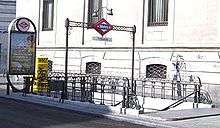
At the beginning of the 1990s, control of the network was transferred to a public enterprise, Metro de Madrid. More large-scale expansion projects were carried out. Lines 1, 4 and 7 were extended and a new line 11 was constructed towards the outlying areas of Madrid. Lines 8 and 10 were joined together into a longer line 10 and a new line 8 was constructed to expand the underground network towards the airport. The enlarged line 9 was the first to leave the outskirts of Madrid to arrive in Rivas-Vaciamadrid and Arganda del Rey, two towns located in the southeast suburbs of Madrid.
In the early 2000s, a huge project installed approximately 50 km (31 mi) of new metro tunnels. This construction included a direct connection between downtown Madrid (Nuevos Ministerios) and the airport, the lengthening of line 8, and adding service to the outskirts with a huge 40 km loop called MetroSur serving Madrid's southern suburbs.
MetroSur, one of the largest ever civil engineering projects in Europe, opened on 11 April 2003. It includes 41 km (25 mi) of tunnel and 28 new stations, including a new interchange station on Line 10, which connects it to the city centre and stations linking to the local train network. Its construction began in June 2000 and the whole loop was completed in less than three years. It connects Getafe, Móstoles, Alcorcón, Fuenlabrada, and Leganés, five towns located in the area south of Madrid.
Most of the efforts of Madrid regional government in 2000s were channeled towards the enlargement of the Metro network. In the 2003–2007 term, President Esperanza Aguirre funded a multibillion-dollar project, which added new lines, and joined or extended almost all of the existing metro lines. The project included the addition of 90 km (56 mi) and the construction of 80 new stations. It brought underground railway to many districts that had never previously had Metro service (Villaverde, Manoteras, Carabanchel Alto, La Elipa, Pinar de Chamartín) and to the eastern and northern outskirts as well (Coslada, San Fernando de Henares, Alcobendas, San Sebastián de los Reyes). For the first time in Madrid, three interurban light rails (Metro Ligero or ML) lines were built to the western outskirts (Pozuelo de Alarcón, Boadilla del Monte) - mL2 and mL3 - and to the new northern districts of Sanchinarro and Las Tablas - mL1. As a last minute addition, a project on line 8 connected it to the new T4 terminal of Madrid-Barajas Airport.
There are numerous expansion and improvement projects pending; many suspended due to the financial crisis since 2009. For example, lines 1 and 5 reaching Valdebebas, extending line 11 further north towards Atocha railway station and beyond, as well as extending line 9 to the north, opening the station Arroyo del Fresno on line 7 and extending line 3 further south.
Station design and setup


The age of Madrid Metro stations is evident in their design: older stations on the narrow lines are often quite compact, similar to the stations on the Paris Metro. They were decorated with tilings in different colour schemes depending on the station. In recent years, most of these stations have been refurbished with single-coloured plates matching those in the newest ones. The stations built between the late 70s and the early 90s are slightly more spacious and most of them have cream colored walls.
On the other hand, the most recent stations are built with space in mind, and have natural-like lighting and ample entryways. The colour scheme varies between stations, using single-colored plates and covering the whole station in light colors. Recently built transfer stations have white walls, but this is not the norm.
Most stations are built with two side platforms, but a handful of them (the busiest transfers) have a central island platform in addition to the side platforms theoretically dedicated to exits. This system was originally used on the Barcelona Metro and is called the Spanish solution. The 12 stations with this setup are:




Two stations have cross-platform interchange arrangement with two island platforms, which allows extremely fast transfers between lines. Both of these stations are on Line ![]()
![]()
![]()
![]()
In addition, 10 stations are built with just one island platform instead of the usual side platforms. These stations are:







Another system is where there is one island platform with one side platform. This system is used in two stations on lines 2 and 4 as termini, and three stations on Lines 7, 9, and 10 where it is required for passengers to change to smaller trains to continue their journeys, normally to towns outside Madrid like Alcobendas or Coslada. This is done so the island platform can be used for passengers to change easily between trains. These stations are:
Overhead power supply system
Since 1999 Metro de Madrid has used a patented system for its installations: a solid rail hung from the ceiling of the tunnels, instead of the usual copper or aluminium wire hung from overhead gantries at regular intervals. This type of overhead line is rigid, making it more robust and less prone to failures. Installations outside of tunnels are rare, as they require many more support structures compared to traditional wire based overhead lines, making them more expensive to install. This system of rigid overhead power supply is also used in other metro systems.
Lines
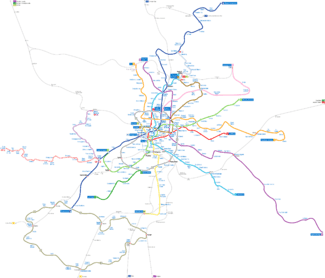
The Metro network has 301 stations on 13 lines plus one branch line, totalling 294 kilometres (183 mi),[16] of which approximately 96% of stations are underground.[17] The only surface parts are between Empalme and west of Eugenia de Montijo (![]()
![]()
![]()
Traditionally, the Madrid metro was restricted to the city proper, but today nearly one third of its track length runs outside the border of the Madrid municipality. Today, the Metro network is divided in six regions:[18]
- MetroMadrid (zone A): the core network inside the Madrid city borders, with over two thirds of the overall length. Also includes the light rail line

- MetroSur (zones B1 and B2): line


- MetroEste (zone B1): a prolongation of line

- MetroNorte (zone B1): opened in 2007, includes the stretch of line

- MetrOeste (zones B1 and B2): comprised by the Metro Ligero lines



- TFM (zones B1, B2 and B3): a prolongation of line

At most of the borders between the regions, one has to switch trains even when staying in the same line, because the train frequency is higher in the core MetroMadrid than in the outer regions.
Madrid also has an extensive commuter train (Cercanías) network operated by Renfe, the national rail line, which is intermodal with the metro network. In fact, 22 Cercanías stations have connections to the Metro network, which is indicated on the official map by the Cercanías logo. Many of the new lines since 1999 have been built to link to or end at Cercanías stations, like the ML2 line, which ends at the Aravaca station providing a fast entry into Madrid though the C-7 or C-10 commuter lines and arriving in only one step to the bus and Metro hub Príncipe Pío (![]()
![]()
![]()
| Line | Termini[18] | Length | Number of stations[18] | Average distance between stations | Loading gauge | Platform length | Rolling stock | Train configuration |
|---|---|---|---|---|---|---|---|---|
| Pinar de Chamartín – Valdecarros | 23.876 km (14.8 mi) | 33 | 746 m (816 yd) | narrow | 90 m | CAF s. 2000-A | M.R-M.R-R.M | |
| Las Rosas – Cuatro Caminos | 14.031 km (8.7 mi) | 20 | 738 m (807 yd) | 60 m | CAF s. 3000 | MRRM | ||
| Villaverde Alto – Moncloa | 16.424 km (10.2 mi) | 18 | 966 m (1,056 yd) | 90 m | CAF s. 3000 | MRSSRM | ||
| Argüelles – Pinar de Chamartín | 16.0 km (9.9 mi) | 23 | 727 m (795 yd) | 60 m | CAF s. 3000 | MRRM | ||
| Alameda de Osuna – Casa de Campo | 23.217 km (14.4 mi) | 32 | 749 m (819 yd) | 90 m | CAF s. 2000-B | M.R-M.R-R.M | ||
| Circular | 23.472 km (14.6 mi) | 28 | 869 m (950 yd) | wide | 115 m | CAF s. 5000 & 8400 | M.M-M.M-M.M | |
| Hospital del Henares – Estadio Metropolitano – Pitis | 32.919 km (20.5 mi) | 31 | 1,097 m (1,200 yd) | AnsaldoBreda s. 9000 | MRSSRM | |||
| Nuevos Ministerios – Aeropuerto T4 | 16.467 km (10.2 mi) | 8 | 2,352 m (2,572 yd) | CAF s. 8000 | MRSM | |||
| Paco de Lucía – Puerta de Arganda – Arganda del Rey | 39.5 km (24.5 mi) | 30 | 1,362 m (1,490 yd) | CAF s. 5000 & AnsaldoBreda s. 9000 | M.M-M.M-M.M | |||
| Hospital Infanta Sofía – Tres Olivos – Puerta del Sur | 36.514 km (22.7 mi) | 32 | 1,177 m (1,287 yd) | AnsaldoBreda s. 7000 | MRSSRM | |||
| Plaza Elíptica – La Fortuna | 8.5 km (5.3 mi) | 7 | 1,417 m (1,550 yd) | CAF s. 8400 | MRSM | |||
| MetroSur | 40.96 km (25.5 mi) | 28 | 1,517 m (1,659 yd) | CAF s. 8000 | MRM-MRM | |||
| Ópera – Príncipe Pío | 1.092 km (0.7 mi) | 2 | 1,092 m (1,194 yd) | narrow | 60 m | CAF s. 3000 | M.R-R.M | |
| Pinar de Chamartín – Las Tablas | 5.395 km (3.4 mi) | 9 | 674 m (737 yd) | tramway | 32 m | Alstom Citadis 302 | MRRRM | |
| Colonia Jardín – Estación de Aravaca | 8.680 km (5.4 mi) | 13 | 723 m (791 yd) | |||||
| Colonia Jardín – Puerta de Boadilla | 13.699 km (8.5 mi) | 16 | 913 m (998 yd) |
Notes:
- Line

- Old stations are not accessible to people with disabilities but since 1995 all new stations must be accessible by law. Thus, both new stations and renewed old ones have elevators for people on wheelchairs, huge signs for the visually impaired, etc.
- All narrow loading gauge lines except line



- Configurations: M - engine (Motor), R - passive (Remolque), S - cabless engine (motor Sin cabina). Dots/dashes mean crossable/complete basic unit separation, while their absence implies a walkable aisle throughout the joined units.
- Alstom Citadis 302 tramways have one motor "car", one suspended, one with bogie but without motors, one suspended, one motor.
- The three ML (Ligero) lines are 1,435 mm (4 ft 8 1⁄2 in) standard gauge. All other lines use 1,445 mm (4 ft 8 7⁄8 in) gauge, the only railway using a specific Italian gauge outside of Italy.
Rolling stock
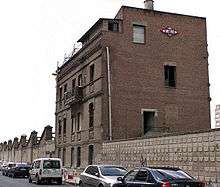
Traditionally, the trains operating in the Madrid Metro have been built and supplied by the Spanish company Construcciones y Auxiliar de Ferrocarriles (CAF). This was particularly true under Francisco Franco's dictatorship, due to the politic of autarky his administration initially pursued. However, despite CAF still working for the Metro, in recent years the Italian AnsaldoBreda has also provided trains for the wide-profile lines.
Every rolling unit in the Madrid Metro has a unique ID that singles it out in the whole network. Those IDs are grouped by the rolling unit model (the "series") and thus is used to categorize the trains, as they bear no user-visible statement of the model specified by the manufacturer. An ID is made up of:
- A letter indicating the type of rolling unit: M for a car with both engines and driver's cabin (Spanish Motor), R for an engineless car, with or without drivers cabin (Spanish Remolque) and S for a cabinless car with engines (Spanish motor Sin cabina).
- A dash separating the two components
- A three or four digit number indicating the unit's series and the position within it. Usually, the series is indicated by the thousands and hundreds (i.e. 5281 indicates a series 5000, subseries 200 train).
Trainsets currently in use
Narrow profile
CAF series 2000: This series has two separate sub-series usually called A and B. The first batch, while reliable and practical, was extremely "box-like" in its looks. They are nicknamed 'Pandas', after a car by Seat with the same name and similar boxy design. In contrast, the B sub-series train sets can be told apart by its sleeker, rounder forms, which has granted them the nickname of "bubble" (burbuja) for their round driver cabin window. Series 2000A are currently the more numerous in the network: 530 cars[19] were built and delivered between 1985 and 1993,[20] having serviced every narrow profile line. They are also among the oldest stock in operation in the Madrid Metro. The most reliable ones are being refurbished and painted with new, lighter colors like the ones used in Series 3000, and will continue to service line ![]()
![]()
.jpg)
CAF series 3000: The newest of the narrow line trainsets, series 3000 were commissioned for the reopening of line ![]()
![]()
![]()
![]()
![]()
Wide profile
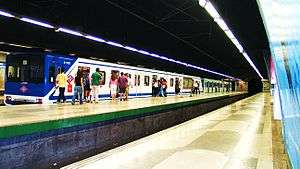
CAF series 5000: Currently servicing line ![]()
![]()
![]()
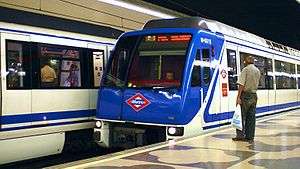
CAF series 6000: This model, of which 29 trainsets were built and delivered in 1998,[24] was the first by CAF to feature a new, sleeker and rounder design. As it was to serve TFM, the stretch of line ![]()
![]()
Ansaldobreda series 7000 & 9000: The first purchase to a manufacturer other than CAF, and to a non-Spanish dealer, 37 series 7000 trainsets service the extremely busy line ![]()
![]()
![]()
![]()
![]()
![]()
CAF series 8000: Originally designed for the MetroSur line ![]()
![]()
![]()
![]()
![]()
![]()
CAF series 8400: Derived from the recent series 8000 trains, the 8400 series are the newest train type to enter service on the Madrid Metro on line ![]()
![]()
![]()
Light rail (named Metro Ligero)
Alstom Citadis 302: The vehicles serving the light rail lines are low-floor articulated trams in a five-section "boa" configuration, which allows for a maximum of about 200 passengers per tram (60 seated). They can reach a top speed of 100 km/h (65 mph), but in practice they are limited to 70 km/h (45 mph) in most track stretches, and even less in urban sprawls. The tram features a bell-like proximity warning that is activated when the train approaches a station or a level crossing with pedestrians, which has given rise to complaints from people living near the tracks because of the noise generated. Safety features also include door activity warnings for passengers and emergency brakes comparatively more effective than in any other train dedicated to Metro service, as the trams, though remaining in their own lanes separated from other traffic, can cross roads and populated areas.
Currently, Metro Ligero has four lines, and one of them is located outside of Madrid:
- Metro Ligero 1/Line ML-1: Pinar de Chamartín - Las Tablas: 5,4 km and 9 stations, 5 of which are underground.
- Metro Ligero 2/Line ML-2: Colonia Jardín – Estación de Aravaca: 8,7 km and 13 stations, 3 of which are underground.
- Metro Ligero 3/Line ML-3: Colonia Jardín – Puerta de Boadilla: 13,7 km and 16 stations, 1 of them is underground - and is shared with ML-2.
- Metro Ligero 4/Line ML4: Tranvía de Parla: 8,3 km and 15 stations.
Historic rolling stock

Until the early 1990s and the transfer of the Metro system to the Autonomous Community of Madrid, the rate of investment in the network by the central government was extremely low,[34] and thus very old trains were used way beyond their intended lifespans. Particularly loathed was the case of line ![]()
![]()
![]()
Fares
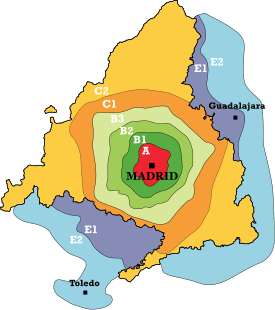
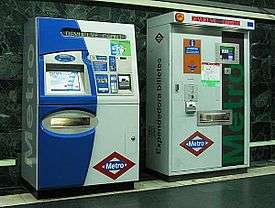
The Madrid Metro network is split into the six "functional" zones mentioned above. Each one has a "single" ticket (Billete Sencillo), valid for one trip within the zone, and a 10-trip ticket for a comparatively lower price. When crossing zone boundaries, one has to buy a new ticket for the zone being entered. There is also a "combined" ticket, which provides for a single trip between any two points of the network except the Airport stations, which have an additional supplement of €3. All in all, it is possible to go from the airport to any other point of the network for up to €5.00.[35]
Also, the Consorcio Regional de Transportes (Regional Transportation Authority) has a division of its own, with geographic zones named A through C2. This body sells monthly and annual passes for unlimited trips within their zone of validity, and also a range of Tourist Passes for 1, 3, 5 or 7 days. All of them are accepted at the Metro stations within their zones, and passengers using a CRT pass do not have to pay the airport supplement.
| Name | Valid for | Expires after | Price | |
|---|---|---|---|---|
| MetroX Sencillo | MetroX zone | 1 trip | €1.50 - max €2.00 | |
| Metrobús | MetroMadrid and EMT buses | 10 trips | €12.20 | |
| MetroX 10 viajes | MetroX | |||
| Sencillo Combinado | Whole network | 1 trips | €3.00 | |
| Abono Transportes Joven | A - C2 (<26 y.o.) | One calendar month | €20 | |
| Abono Transportes Normal | A - C2 | €51.30 - €93.20 | ||
| Abono Transportes 3ª Edad | A - C2 (>65 y.o.) | €11.60 | ||
| Abono Transportes Annual Normal | A - C2 | One calendar year | €523.60 - €950.40 | |
| Abono Transportes Annual 3ª Edad | A - C2 (>65 y.o.) | €119.90 | ||
| Abono Turístico | A | 1 – 7 days | €8.00 - €33.40 | |
| Abono Turístico | T (all CRT zones) | €16.00 - €66.00 | ||
| TICKETS WITH ORIGIN-DESTINATION AIRPORT | Single ticket + Supplement (*) €4.50 5.00 | Combined Single ticket €6.00 + Supplement | Airport Ticket €3.00 Supplement | Airport Express bus ticket €5.00 |
Operators
The metro is operated by its own company, under the Department of Public Works, City Planning, and Transportation of the autonomous community of Madrid. The passage between Puerta de Arganda (Line 9) and Arganda del Rey (Line 9) is operated by Transportes Ferroviarios de Madrid (TFM). All of Madrid's rapid transit systems are members of the Consorcio Regional de Transportes, which sells monthly passes for unlimited use of the metro, bus and commuter train networks within the area covered by the pass.
See also
Notes
- 1 2 3 "Metro de Madrid Figures". Metro de Madrid. Retrieved 5 July 2015.
- ↑ name="metromadrid""Metro de Madrid registró en 2017 el mayor aumento de viajeros desde 2000, con un 7,22 %". Metro de Madrid. Retrieved 10 May 2018.
- ↑ "Public transport in Madrid in Spain: spain.info in english". Retrieved 18 August 2016.
- ↑ Von Mach, Stefan (March 2008). "Madrid Light Rail: Three lines to feed the metro". Metro Report International, of Railway Gazette International (UK).
- ↑ Moya, Aurora. Metro de Madrid, 1919–1989. Setenta años de historia. Madrid, Spain. pp. 34–35. ISBN 978-84-613-6154-0.
- ↑ Moya, Aurora. "Metro de Madrid, 1919–1989. Setenta años de historia".
- 1 2 Metro de Madrid. "History: 1919". metromadrid.es. Retrieved 2 September 2018.
- 1 2 3 Moya, Aurora. Metro de Madrid, 1919–1989. Setenta años de historia. Madrid, Spain. p. 48. ISBN 978-84-613-6154-0.
- ↑ Parsons, Deborah L. A Cultural History of Madrid: Modernism and the Urban Spectacle. Oxford International Publishers Ltd. p. 79. ISBN 1-85973-646-7.
- ↑ Stewart, Jules. Madrid: The History. I.B. Tauris. p. 142.
- ↑ Moya, Aurora. Metro de Madrid, 1919–1989. Setenta años de historia. Madrid, Spain. p. 50. ISBN 978-84-613-6154-0.
- ↑ Moya, Aurora. Metro de Madrid, 1919–1989. Setenta años de historia. Madrid, Spain. p. 51. ISBN 978-84-613-6154-0.
- ↑ Moya, Aurora. Metro de Madrid, 1919–1989. Setenta años de historia. Madrid, Spain. p. 53. ISBN 978-84-613-6154-0.
- ↑ Moya, Aurora. Metro de Madrid, 1919–1989. Setenta años de historia. Madrid, Spain. p. 54. ISBN 978-84-613-6154-0.
- ↑ "Internet Archive Wayback Machine". Web.archive.org. 25 April 2009. Archived from the original on 25 April 2009. Retrieved 31 October 2012.
- ↑ Metro de Madrid (2017). "Metro de Madrid in figures". metromadrid.es. Retrieved 2 September 2018.
- ↑ There are 8 out of 231 stations that are not underground, which amounts to just 4% of the total, though the aboveground route length may be longer.
- 1 2 3 4 5 6 7 8 9 10 "RED DE METRO Y METRO LIGERO" (PDF). metromadrid.es. Metro de Madrid. Retrieved 17 August 2016.
- ↑ Trainset sizes vary between lines: 90m lines use six cars per train, while 60m lines use only four. Thus the actual number of trains varies between 88 and 132.
- ↑ CAF description for s.2000A Archived 27 September 2007 at the Wayback Machine. (reversed, title says 2000B)
- ↑ CAF description for s.2000B Archived 13 January 2009 at the Wayback Machine. (reversed, title says 2000)
- ↑ Andén 1 - Historia del Metro Archived 14 November 2007 at the Wayback Machine.
- ↑ CAF description for s.5000 Archived 27 September 2007 at the Wayback Machine. - sales information and photos correspond to subseries 5500
- ↑ "CAF - Construcciones y Auxiliar de Ferrocarriles". Archived from the original on 26 June 2012. Retrieved 18 August 2016.
- ↑ enelSubte.com (29 July 2013). "SBASE compra a Metro Madrid 73 coches usados CAF 6000 para la línea B". Retrieved 18 August 2016.
- ↑ enelSubte.com (28 January 2014). "Metro de Madrid despacha los primeros CAF 6000". Retrieved 18 August 2016.
- ↑ enelSubte.com (20 May 2013). "Planearían renovación masiva de flota en la línea B". Retrieved 18 August 2016.
- ↑ enelSubte.com (24 January 2014). "Trenes Mitsubishi convivirán con los CAF 5000 y 6000 en la línea B". Retrieved 18 August 2016.
- ↑ Danna, Roby (29 July 2013). "Subtes: Ciudad compra más de 70 vagones Serie 6000 a Madrid - Noticias de Buenos Aires al instante". Retrieved 18 August 2016.
- ↑ http://www.ferronoticias.net/2014/01/28/serie-6000-metro-de-madrid-argentina/
- ↑ MADRID, METRO DE. "Metro de Madrid ingresa 32,6 millones de euros con la tercera venta de trenes a Buenos Aires - Metro de Madrid". Retrieved 18 August 2016.
- ↑ La peor compra de material rodante de la historia del Subte - EnElSubte, 6 March 2015.
- ↑ "CAF - Construcciones y Auxiliar de Ferrocarriles". Archived from the original on 26 June 2012. Retrieved 18 August 2016.
- ↑ A similar case happens as of 2008 with the Cercanías commuter network, as the Spanish government is focused in the expansion of the nationwide AVE high speed network
- ↑ "Tickets". www.metromadrid.es. Metro de Madrid. Retrieved 2016-08-18.
External links
| Wikimedia Commons has media related to Madrid Metro. |
- Official website

- Schematic map of the Metro network – from the official site (in English)
- Madrid at UrbanRail.net
- Consorcio Regional de Transportes de Madrid
- Andén 1 – Association of friends of Madrid Metro
- ENGLISH User guide, ticket types, airport supplement and timings
- Network map (real-distance)
- Madrid Metro Map
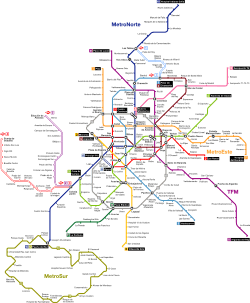

_L%C3%ADnea_10_de_metro_(1).jpg)
